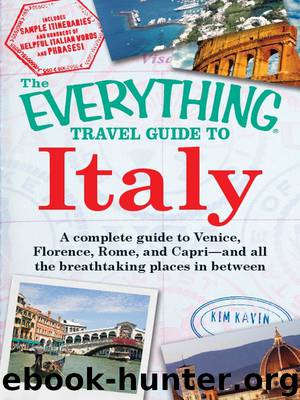The Everything Travel Guide to Italy by Kim Kavin

Author:Kim Kavin
Language: eng
Format: epub
Tags: ebook, book
Publisher: Adams Media, Inc.
Published: 2010-07-15T00:00:00+00:00
Ancient Sites
Pompeii is the best known of the ancient sites in the Campania region. However, it isn’t the only one. Pompeii’s sister city, Herculaneum, and the remains of the Greco-Roman city known as Paestum also have beautifully preserved structures.
Pompeii
The Roman city of Pompeii thrived until the two-day-long eruption of the 4,200-foot-tall Mount Vesuvius in the year A.D. 79. The suffocating black blanket of earthen innards that spewed from the volcano’s mouth buried the city beneath the equivalent of six stories of rubble. It was lost for some 1,700 years until it was rediscovered during excavation work in the mid-1700s.
Because no oxygen could reach the virtually entombed buildings and bodies beneath the ground, decomposition was kept relatively at bay. Many of the locations where residents undertook day-to-day activities remain well preserved, including the city’s forum, baths, and houses. The remains draw more than 2 million visitors each year, and the area has been named a UNESCO World Heritage Site.
Fact
The eruption of Mount Vesuvius occurred the day after Vulcanalia, the festival of the Roman god of fire. The volcano had been dormant for 800 years. Some sixty feet of lava, dirt, and ash buried the people and the city. One of those killed was the philosopher Pliny the Elder, who reportedly perished while trying to rescue others who were stranded.
Pompeii’s ruins are part of Vesuvius National Park and are easily accessible if you walk to one of the multiple entrances from the modern-day city of Pompeii, which is served by trains daily. Allow yourself at least half a day to look around; most people find the ruins so vast and interesting that they wander and explore for a good four hours.
Herculaneum
Herculaneum, a neighboring city to ancient Pompeii that also perished in the Mount Vesuvius eruption, was actually the first of the two cities to be rediscovered in the mid-1700s. Herculaneum was smaller yet wealthier than Pompeii, and some of the structures that have been unearthed are believed to be large private houses and luxurious villas. One is even said to have been used as a seaside retreat by Julius Caesar’s father-in-law.
Fact
It was not a volcanic eruption but the development of marshy conditions that led citizens to abandon the ancient city of Paestum. It is believed that the direction of water flow changed, leading to a swamp-like environment. The area was infested with malaria-carrying mosquitoes, which made it uninhabitable.
The ruins at Herculaneum are just as well preserved as those of Pompeii, and the crowds tend to be smaller at Herculaneum. You can get there by taking a train to the Ercolano Scavi station, then walking or taking a taxi about a mile downhill to the ruin entrance.
Paestum
The Greco-Roman city of Paestum was originally known as Poseidonia, a reference to Poseidon, the Greek god of the sea. It is believed to have been founded during the seventh century B.C., and archaeological evidence shows that as the city developed throughout the centuries, it included a system of roads, temples, and coins used for trade. Civilization
Download
This site does not store any files on its server. We only index and link to content provided by other sites. Please contact the content providers to delete copyright contents if any and email us, we'll remove relevant links or contents immediately.
